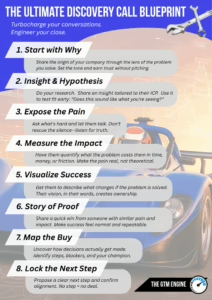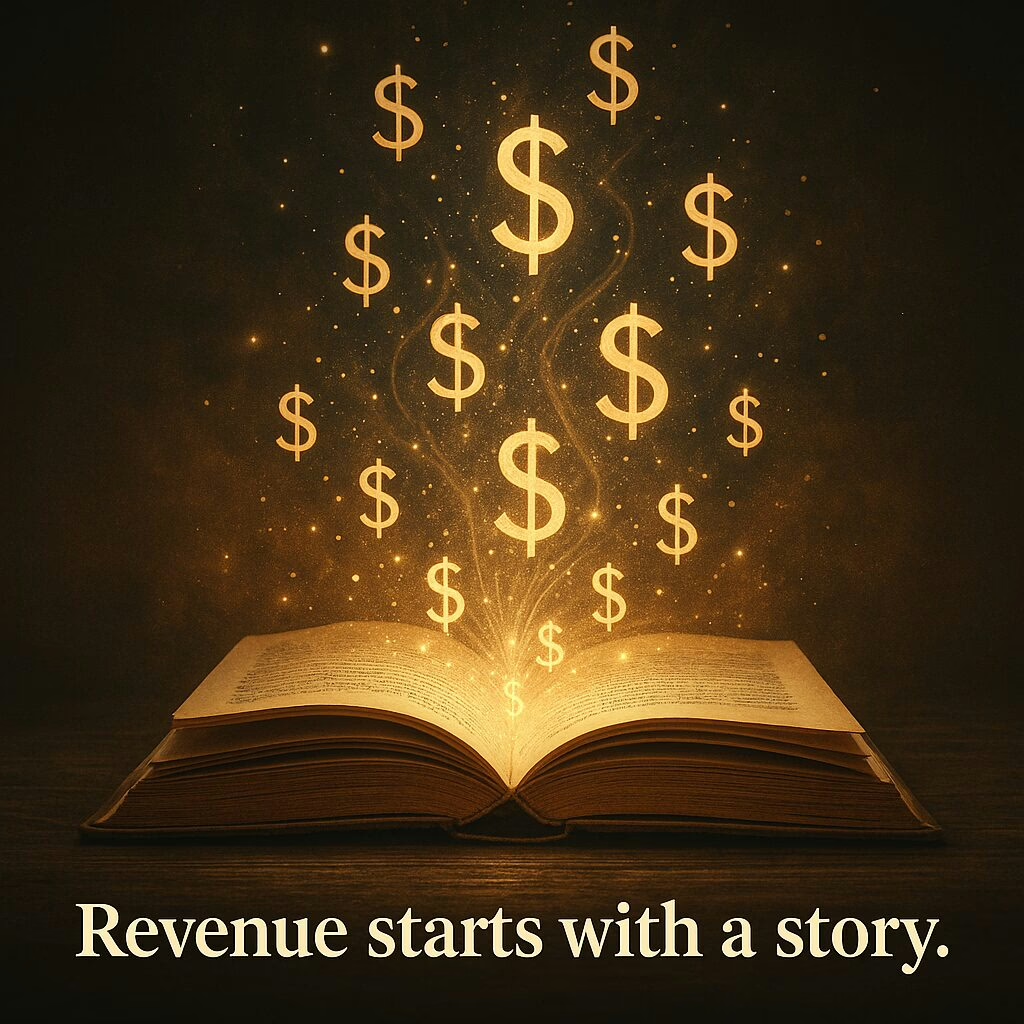- Intro
- What Is Founder Storytelling in B2B?
- Why Feature Lists Don’t Convert (And Founder Storytelling Drives Pipeline Performance)
- The 2 Stories Every Founder Needs (And Every Investor Should Look For)
- How Founder Storytelling Transformed Our Results at Bitcoin++ (With Measurable ROI)
- How to Bake Storytelling Into Your GTM Strategy (or Assess It During Diligence)
- What’s Next?
Intro
Founder storytelling is paramount, but before I understood good, strategic storytelling, I tried everything else.
At Qv21, I built out a Challenger-style sales process—complete with reframes, insight pitches, and structured talk tracks. It worked… sometimes. But too often, the insight fell flat. It felt like I was giving a TED Talk to buyers who just wanted help solving their problems.
I knew I needed a better way to connect. But analogies and clever narratives weren’t landing either. They either confused the audience or felt forced coming out of my mouth.
Then I read Stories That Stick by Kindra Hall.
It didn’t just change how I thought about storytelling—it gave me a structure. One I could use. One I could teach. One that made storytelling practical.
At CORE, I used that framework to build a full GTM system:
- Founder story to clarify the “why we exist”
- Customer stories built on voice-of-customer pain
- Case studies that moved from relatable pain → quantified impact → unexpected upside
We started to get traction. New clients were engaging. Messaging was resonating.
Then the private equity money fell through. The healthcare vertical I’d been building for? Gone.
The system never had a chance to scale.
But I used the same structure at bitcoin++—and this time, it ran.
📈 3× YoY revenue
💰 2× average deal size
✅ 60%+ close rates
⏱️ Sales cycles cut in half
That’s when I stopped calling storytelling “fluff” and started calling it infrastructure.
And now I help other founders—and the investors backing them—build go-to-market systems that convert because they’re story-driven.
What Is Founder Storytelling in B2B?
People Also Ask:
- What is storytelling in B2B?
- Why is storytelling important for founders?
Most people think of storytelling as a branding tool—or something reserved for TED speakers and charismatic CEOs. But in B2B sales, founder storytelling isn’t just inspirational. It’s functional.
It’s how you give meaning to your mission.
It’s how you make your product memorable.
It’s how you scale sales beyond yourself.
In founder-led companies, the founder is often the best salesperson—not because they’re the most persuasive, but because they carry the story. They can connect the dots between product features and buyer pain in a way no one else can.
But here’s the problem:
When that story lives only in the founder’s head, the company can’t scale.
And when that story never existed in the first place, sales become a grind of feature pitching and premature discounting.
True founder storytelling answers three unspoken buyer questions:
- Why do you exist?
- Why does this matter to me?
- Why should I believe you?
Founders who can answer those through story—not just slides—create a foundation that marketing can scale and sales teams can execute.
And for investors, that story is one of the clearest indicators of GTM maturity. If a founder can’t tell it—and no one else on the team can either—you’re not looking at a company. You’re looking at a bottleneck.
Why Feature Lists Don’t Convert (And Founder Storytelling Drives Pipeline Performance)
People Also Ask:
- Why are stories more effective than facts?
- Do stories convert more in sales?
Most early-stage pitches are a rapid-fire rundown of features, benefits, and roadmaps.
Founders say things like:
- “We integrate with 40+ tools.”
- “We cut costs by 27%.”
- “We use AI to automate [insert function here].”
It all sounds impressive—until you realize none of it actually sticks.
🔍 Here’s what real data shows:
- Stories are far more memorable.
Stanford’s Jennifer Aaker found stories to be up to 22× more memorable than data alone.
Another experiment had students using narrative memory techniques—leading to 6–7× better recall than non-narrative learning. - Storytelling boosts engagement and conversions.
B2B brands that integrate narrative techniques report a 30%+ increase in qualified lead engagement.
Anecdotal tests (like the “story paint-job” for thrift products) increased perceived value by over 2,700%. - Neuroscience confirms it works.
Story-based messaging activates up to three times more brain regions compared to fact-only communication—and even triggers emotional centers like oxytocin release.
What This Means for B2B Founders & Investors
- Demo show rates are lower, and buyers drop off before seeing value.
- Feature-heavy pitches drive price wars, not value-based buying.
- Deals stall — clients don’t connect emotionally, so they hesitate.
The core issue:
People don’t buy features. They buy what those features do—and how they feel along the journey.
A well-crafted customer story (pain → impact → opportunity realized) doesn’t just land—it resonates, engages, and converts. That’s how deals close faster, pipelines grow deeper, and teams scale beyond founders.
The 2 Stories Every Founder Needs (And Every Investor Should Look For)
People Also Ask:
- What stories should a founder tell?
- How do I make my sales pitch more human?
- What storytelling is useful in B2B sales?
In every founder-led company I’ve worked with, there’s a dangerous assumption:
“Our pitch is clear… we just need more reps.”
But when you sit in on their demos or read their decks, you find a familiar pattern:
A flurry of features. Some vague benefits. No emotional connection. No real proof.
When you do find a company scaling smoothly, it’s almost always because they’ve nailed two foundational stories:
1. The Founder Story — “Why We Exist”
This isn’t about your resume.
It’s about your mission and relevance.
The best founder stories answer:
- What pain in the world did you see?
- Why were you uniquely frustrated enough to solve it?
- What insight changed how you approached it?
- Why does that matter to the customer right now?
This story gives meaning to your product—and helps customers and employees alike feel emotionally aligned with the company’s direction.
Investor POV:
Founders who tell strong origin stories don’t just attract customers—they attract talent, press, and partner confidence.
2. The Customer Story — “Why It Matters to Buyers”
This is the story that actually closes deals.
It needs to move from:
- Relatable Pain – something your ideal buyer immediately recognizes
- Quantified Impact – what that pain costs them (in time, money, morale, or risk)
- Resolution + Opportunity Unlocked – what happens after the fix (including unexpected upside)
💡 Bonus: Avoid the “testimonial trap” where customers say generic things like “they were great to work with.”
Instead, craft case studies that tell a transformation story—from struggle to solution.
Investor POV:
Ask founders: “If I hired a new AE tomorrow, could they tell this customer story—and close a deal with it?”
If the answer is no, your GTM isn’t repeatable.
How Founder Storytelling Transformed Our Results at Bitcoin++ (With Measurable ROI)
People Also Ask:
- What’s an example of effective founder storytelling?
- How do stories improve GTM performance?
- How do I know if storytelling is working in my sales strategy?
At bitcoin++, storytelling wasn’t a garnish on top of the pitch—it was the pitch.
Every discovery call followed a consistent structure:
- It opened with a Founder Story to anchor why the product existed and why it mattered now. This built rapport and opened the conversation to better communication about the prospect’s situation and goals.
- It transitioned into a Customer Story designed to resonate with the buyer’s pain—showing the before state, the cost of doing nothing, and the transformation once solved.
We didn’t need stage time or press.
Just structured stories delivered consistently on real calls.
To support the team, we built a 5-page brochure that acted as a lightweight Champion Package—a tool that let interested buyers champion the solution internally without needing a salesperson on every call.
The result?
- 📈 3× YoY revenue growth
- 💰 2× increase in average deal size
- ⏱️ Sales cycles cut by more than half
- ✅ 60%+ close rates
These weren’t just good numbers—they were proof that our storytelling wasn’t just compelling, it was scalable.
When founders stop selling features and start sharing meaningful, structured stories—buyers stop needing to be convinced. They start believing.
And when buyers believe, deals move.
How to Bake Storytelling Into Your GTM Strategy (or Assess It During Diligence)
People Also Ask:
- How do I incorporate storytelling into my sales strategy?
- How can VCs assess go-to-market maturity in startups?
- What makes messaging repeatable and scalable?
You don’t need to be a “natural storyteller” to build a story-driven GTM motion.
You need a structure—and a team that can carry it forward.
Here’s how to make it real:
Founders: Start With These 2 Stories
- The Founder Story
Frame your mission not as an origin tale, but as a buyer-relevant why.
Write it down. Share it in every first call. Make sure your team can repeat it in their own words. - The Customer Story
Choose one real customer win and turn it into a reusable narrative.
Use the structure:- Pain: What did they struggle with?
- Impact: What was the cost?
- Resolution: How did you solve it?
- Upside: What unexpected value did they gain?
Don’t wait for perfect copy.
Start sharing it live. Then refine based on what resonates.
As you operationalize this, ensure the org design and leadership mandate support it. See the Chief Commercial Officer guide.
VCs & PE Partners: Use Storytelling as a Diligence Litmus Test
When evaluating GTM readiness:
- Ask the founder to tell their Founder Story and a Customer Story.
- Then ask: “Could your AE tell this story tomorrow and close a deal?”
- If not, you’ve got a messaging bottleneck—not a headcount problem.
The presence (or absence) of repeatable stories tells you:
- Whether the company can scale sales
- How fast they can enable new reps
- Whether they’ve transitioned from founder-dependent to system-driven revenue
Turn Story Into System
Storytelling isn’t just for pitching. It powers:
- Sales enablement
- Marketing clarity
- Customer trust
- Strategic alignment
Founders who build their GTM around story gain more than resonance.
They gain repeatability. And repeatability is what scales.
A repeatable, scalable system that delivers qualification, connection, and conversion in every call. Systems beat heroics. If you’re still founder-dependent, start here: how to scale revenue without being the one closing every deal.
What’s Next?
Scaling a story-driven GTM often starts with the right commercial leader. Read the Chief Commercial Officer guide.

Founders:
If you’re ready to scale your message—and not just your headcount—you can Download the 1-page Ultimate Discovery Call Blueprint or Schedule a Call to Discuss how I can help your growth.
Investors:
If your portfolio companies are struggling with messaging that doesn’t scale, let’s talk. Schedule a discovery call and I’ll show you how story-driven systems can turn insight into revenue.


Leave a Reply